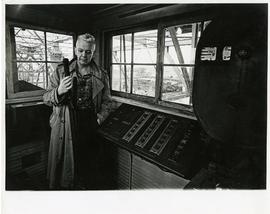Tacoma School District No. 10, known as Tacoma Public Schools, is headquartered in Tacoma, Washington, United States. It comprises 35 elementary schools, 11 middle schools, 10 high schools, and 4 early learning centers. It is the third-largest school district in Washington State, with more than 30,000 students and 5,000 employees. Tacoma Public Schools is one of the largest employers in the greater Tacoma area.
Tacoma School District #10 was established on September 18, 1869, on the future site of Tacoma. (1) The first classes occurred in a resident's log cabin, with 13 students from the Baker, Fleetwood, and A. W. Stewart families. The first school building was a log cabin constructed in 1870, located on the southwest corner of North 28th and Starr Streets. It cost around $300. (1) A.W. Stewart served as a director, J.P. Stewart as a teacher, and R. H. Landsale as a board clerk. (1)
Like the rest of the United States, Tacoma Public Schools was influenced by the influx of European immigrants in the years before World War I. Government and religious agencies worked to address ethnic integration. (2) The National Conference on Immigration and Americanization in 1913 created a list of three critical aspects of immigrant assimilation: literacy, health and hygiene, and learning democracy. (2) In response, U.S. schools began introducing new policies and programs to promote and teach the importance of these three values.
The Tacoma School District began incorporating nurses, health clinics, showers, and home economics departments. The purpose was to improve health and hygiene within the school property. The school district also expanded social services, such as after-school programs, summer school, and the availability of on-site lunches. (2) The focus on the civic responsibilities of schools led to the improvement of libraries, lunchrooms, and administrative offices. (2)
During the early twentieth century, Tacoma and its school system experienced population growth due to the United States' involvement in World War I, including establishing Fort Lewis in 1917 and the 1914 opening of the Panama Canal. The Panama Canal expanded the business and industry associated with the Port of Tacoma; Fort Lewis also became the largest fort in the United States, housing 37,000 soldiers. (2)
From 1915 to 1920, enrollment in Tacoma Public Schools rose from 14,211 to 18,023. (2) In order to address the growing student population, the district school board debated between three educational models. The educational models would affect the construction of schools. The models were the 8-4 system, the 6-6 system, and the 6-3-3 system. (2) The 8-4 system was the typical school model before World War I. It had grades one through eight in elementary schools and nine through 12 in high schools. The 6-6 system recommended grades one through six in elementary school, with grades seven through 12 in high school. (2) The board adopted the 6-3-3 system, which advocated for grades one through six in elementary school, seven through nine in middle school, and 10 through 12 in high school. (2)
Tacoma voters authorized a $2.4 million plan in 1923 to transition to the new elementary, intermediate, and high school model. (2) The funding allowed for the construction of six new intermediate schools and additions to existing elementary schools. As a result, Jason Lee, James P. Stewart, Morton M. McCarver, Franklin B. Gault, Allan C. Mason, and Robert Gray's middle schools were built. (2)
Another significant population increase occurred in Tacoma and its schools during World War II because the Port of Tacoma and Fort Lewis brought economic growth. From 1950 to 1956, public school enrollment rose 26% from 22,157 to 29,778. (2) The increase in student population led to the overcrowding of aging elementary schools. Furthermore, the need for construction in suburban areas caused the school board to draft a new building campaign emphasizing quick, cheap, and flexible school construction. (2)
Following the Brown v. Board of Education decision and the Civil Rights Act of 1964, the Tacoma School District sought to desegregate schools with high non-white enrollment. (3) Dr. Angelo Giaudrone, the district superintendent, addressed the de facto segregation and focused on two elementary schools. The two schools were Stanley Elementary, with a Black population of 64 percent, and McCarver Elementary, with a Black population of 84 percent. Tacoma Public Schools formed a subcommittee in 1963 to study de facto segregation and provide solutions. (3) On July 8, 1966, the school board announced a plan for an optional enrollment program. The program’s goal was to close McCarver Junior High and provide limited open enrollment to students affected by the closing. (3)
After a decade of teaching in the Tacoma School District, Willie Stewart became the first Black principal in 1970. Stewart often liaised between the Black community and the school district. (3) Reflecting on the success of the voluntary desegregation plan, Stewart discussed the wish to have more African American counselors and a two-year education process instead of one year. (3) "Stewart thought the district could also have improved its plan by having high school regional meetings with schools and the community and separate meetings for the Black community to help with the transition with the loss of school lineage." (3) By 1972, the school district stated that de facto segregation had ended in fifty-eight school buildings. All buildings were at or below the forty-percent threshold for black student enrollment. (3)
